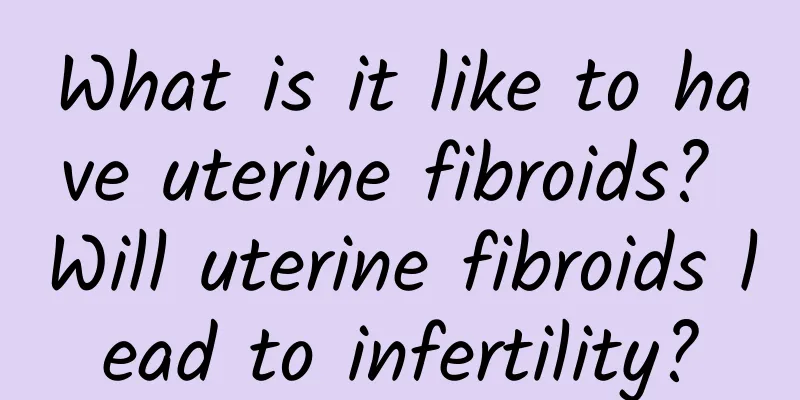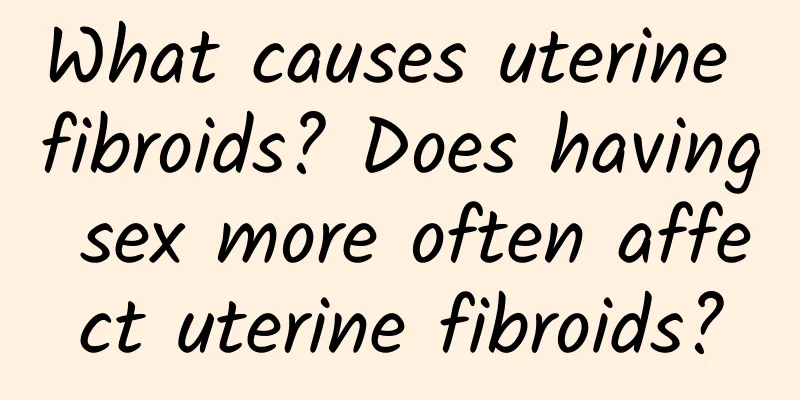What is it like to have uterine fibroids? Will uterine fibroids lead to infertility?

|
Uterine fibroids (Hysteromyoma) Uterine leiomyoma, also known as uterine leiomyoma, is the most common benign tumor of the female genitals. Most of them are asymptomatic, and a few show vaginal bleeding, abdominal contact with the tumor and compression symptoms. Multiple uterine fibroids are common in cases of pedicle torsion or other conditions that cause pain. Uterine fibroids are the most common tumor of the female genitals. At present, the cause is still unclear. If not treated in time, it will lead to female infertility, miscarriage, frequent urination, urination disorders and other hazards, and is the main killer of women's health. The harm of uterine fibroids 1. Infertility or miscarriage: Uterine horn fibroids compress the entrance of the fallopian tubes, deform the uterus, and hinder the implantation of the fertilized egg, ultimately leading to infertility. In addition, according to statistics, the spontaneous abortion rate of fibroid patients is also higher than that of ordinary people, with a ratio of 4:1. 2. Free myoma: Subserosal uterine myoma can twist at the pedicle, causing acute abdominal pain. If the condition is severe, free myoma may form due to the twisting of the tumor pedicle. 3. Secondary anemia: Uterine fibroids can cause excessive menstrual bleeding, which over time can lead to secondary anemia and even promote anemic heart disease. In severe cases, patients will experience adverse symptoms such as general fatigue, pale complexion, palpitations, and shortness of breath. 4. Malignant lesions: Uterine fibroids are benign tumors, but a few can cause malignant changes, which are more common in the elderly. Fibroids grow fast, especially in postmenopausal women, or postmenopausal women with fibroids should be more vigilant. 5. Infection and suppuration: Uterine fibroids can cause pelvic congestion and infection. The infection is mainly caused by tumor pedicle torsion, while blood infection is extremely rare. After infection, a few patients will form abscesses in the tumor tissue, and the rest will be suppurative. 6. Concurrent inflammation: Gynecological inflammation such as adnexitis and pelvic inflammatory disease caused by bacterial invasion. Complications of fibroids are mainly caused by tumor pedicle torsion or acute endometritis. Inflammation is sometimes purulent, and some cases can form abscesses in the tissue. Subserosal fibroid pedicle torsion causes intestinal adhesions, which can be invaded by intestinal bacteria. Inflammatory fibroids adhere to the uterine appendages, causing purulent inflammation. Four points can determine whether there is uterine fibroids Uterine fibroids are a common gynecological disease that can cause symptoms such as menstrual changes and abdominal pain. In severe cases, it can lead to infertility. Women can observe whether they have uterine fibroids through their own symptoms. If symptoms are found, they should go to a regular hospital for examination immediately. There are four main symptoms of uterine fibroids. 1. Abdominal pain Attention should be paid to pain in the lower abdomen, back or sacrum, because sometimes pain is a self-exposure of uterine fibroids, which can cause abdominal pain due to compression of tissues, traction, pedicle torsion, rupture or degeneration by the tumor. 2. Abnormal leucorrhea Normal leucorrhea is a small amount of slightly sticky transparent, egg white-like secretions, which are more than four or five days before and after ovulation, and have no odor. Bloody leucorrhea appears after uterine fibroids, and the leucorrhea increases, sometimes producing a large amount of purulent and bloody discharge and slough-like tissue. 3. Increased menstrual volume If accompanied by long-term increase in menstrual volume, be alert to uterine fibroids. They mainly occur in submucosal and intramural fibroids, and manifest as menorrhagia, prolonged menstruation or irregular vaginal bleeding. The main reason for increased bleeding is the increase in endometrial area. Endometrial congestion hinders uterine contraction and affects blood circulation. Due to long-term bleeding, patients often have varying degrees of anemia. Abdominal mass In the early morning, on an empty stomach, lie flat on the bed when defecating, bend your knees, relax your abdomen, touch your lower abdomen with your hands, breathe from shallow to deep, generally from the other lower abdomen, if there is swelling, it may be found, but also prevent contact with the colon, if there is feces, it may be mistaken for a mass, but at this time it is generally cord-shaped, but if a woman finds a mass or should pay attention, it is best to check it clearly. What should you pay attention to in your diet when you have uterine fibroids? Patients with adenomyosis need to have a high level of understanding of their diet, which is a good guarantee for getting rid of adenomyosis early. Knowing that the symptoms of adenomyosis and uterine fibroids are different, it is better for patients with adenomyosis to drink peach kernel porridge and Achyranthes bidentata wine. The specific method is 10g peach kernel and 30g polished rice. Mash the peach kernel into a paste, remove the residue and take the juice, use the juice to cook polished rice into porridge, twice a day, eat warm on an empty stomach. It is suitable for blood stasis. The method of Achyranthes bidentata wine is 10,000g Achyranthes bidentata and 1500g wine. Seal and soak for a certain amount, and take it warm according to your ability. It has the function of breaking blood and eliminating symptoms. It is mainly used to treat abdominal masses and pain like needles. In addition, what should patients with uterine fibroids eat? They should eat more lean meat, chicken, eggs, kelp, seaweed, fruits, etc., and their daily diet should be light. They should not eat mutton, shrimp, crab, eel, salted fish, black fish and other hair-raising foods. They should avoid spicy foods and drinks such as pepper, pepper, raw onion, raw garlic, and white wine. They should also avoid foods such as longan, red dates, donkey-hide gelatin, royal jelly, etc. that are hot, coagulant, and contain hormones. |
Recommend
Female friends should pay attention to the causes of cervical erosion
Cervical erosion has brought great harm to female...
What are the benefits of Chinese medicine sitz bath for vulvar leukoplakia? How is the effect of Chinese medicine sitz bath?
1. Leukoplakia vulvae is a common skin disease th...
The following content is an introduction to the preparations before abortion:
The phenomenon of abortion has become more and mo...
Advantages of microecological therapy in treating vaginitis
There are many ways to treat vaginitis. Microecol...
What symptoms indicate that I may have an ovarian cyst?
Women's health should be paid special attenti...
Why do infertile women suffer from uterine fibroids? How to treat uterine fibroids
What should women do when they find uterine fibro...
How to treat uterine fibroids? What are the precautions for uterine fibroids?
The treatment of uterine fibroids is often consid...
What is the cause of pelvic inflammatory disease?
What are the causes of pelvic inflammatory diseas...
Analyze the early symptoms of cervicitis for you
Cervicitis is a major disease that many women are...
How to exercise better for irregular menstruation? 4 ways to regulate irregular menstruation through diet
Many women have irregular menstruation, which is ...
When can an ectopic pregnancy be detected?
When can ectopic pregnancy be discovered? Ectopic...
What medicine is better for uterine fibroids? How to use medicine for uterine fibroids
Generally speaking, uterine fibroids refer to com...
Contagious issues with Bartholinitis
Bartholinitis is a common gynecological disease i...
Long-term gastroesophageal reflux may increase the risk of esophageal cancer! Nutritionist Jian Yuhua: 7 tips for preventing gastroesophageal reflux
"belch! How come all the food I ate at noon ...
Diet care for pelvic inflammatory disease
Pelvic inflammatory disease is one of the common ...



![[Video version] Dementia, aging...the brain is playing tricks! 6 essential nutrients for brain protection](/upload/images/67dcfb4c1e4a3.webp)





